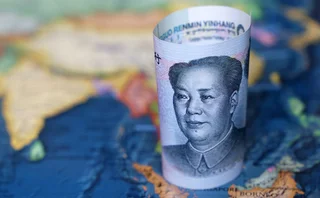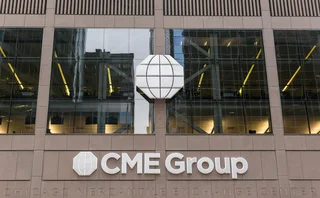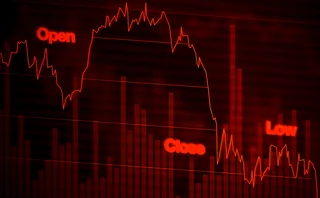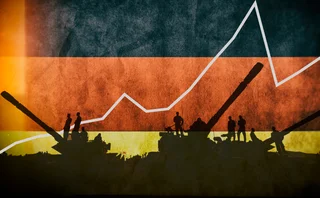
Kings and kingmakers in the Ucits FX forwards market
Counterparty Radar: First look into European retail fund data reveals HSBC and Vanguard as top dealer and manager

Vanguard, JP Morgan Asset Management and BlackRock are the largest buy-side users of foreign exchange forwards among European investment funds, with HSBC the top dealer, according to exclusive new data from Risk.net’s Counterparty Radar service.
Unlike US mutual funds and life insurers, which report quarterly in a predictable format, European Ucits funds’ position and counterparty information is buried in unstructured PDFs released half yearly. But after utilising machine-learning techniques to scrape and aggregate the data, Counterparty Radar was able to analyse the trades of a select population of 2,000 Ucits funds from 23 of the largest managers by assets under management in Europe.
This dataset includes 37,000 trades per half-year increment that amount to a bit over $500 billion of FX forwards trades. In comparison, a quarter’s worth of filings from nearly 12,000 US mutual funds and exchange-traded funds includes roughly 76,000 trades which in the past year averaged close to $900 billion in combined notional (see box: Methodology).
In the new European data, Vanguard extends its dominance across the Atlantic with a book that stood at around $166 billion in the first half (H1) of 2023, the latest period for which data is available, and represented almost one-third of the total of the notional volume tracked. Two other US firms, JP Morgan Asset Management and BlackRock, made up another one-third of the space, with $80 billion and $61 billion, respectively.
Schroders was the largest European manager in the set. The size of the London-based firm’s FX forwards book was $37 billion at the end of H1 2022, when the dataset began. At the end of H2 2022 that had dropped to $32 billion, and by H1 2023 it was down to $30 billion.
Methodology
- The data comes from the filings of 23 of the largest Ucits providers by assets under management. The set covers more than 2,000 individual funds with more than $1.2 trillion in assets under management (as of the end of 2022).
- US mutual fund and ETF filings, as well US life insurance disclosures, follow relatively structured templates required by the US Securities and Exchange Commission and other US regulators. European filings are completely unstructured and exist only in PDF format. To scrape the data, advanced machine learning techniques were utilised. Umbrella entities with incompatible reporting formats were therefore excluded.
- The 23 managers have more than 100 reporting umbrella entities in total, of which Counterparty Radar was able to analyse 36.
- In certain cases, managers have erroneously reported as their counterparty firms that appeared to have served in a custodial capacity in the FX forwards transaction. These volumes were assigned to the catch-all category ‘Counterparty not identified’. We have reasons to suspect that some of the dealer volumes may still reflect custodial relationships, but as these could not be confirmed by publication time, they were included under the bank that the original filing disclosed as the counterparty to the trade.
Meanwhile, HSBC is leading the pack of dealers serving the space. The UK bank’s positions amounted to approximately $109 billion at the end of H1 2023, or a 21% market share of the FX forwards in the dataset. That was significantly up compared to the first half of 2022 when HSBC had roughly $83 billion of the FX forwards trades done by the Ucits funds in the dataset.
Dominance of the passive giant
In the US FX forwards market, Vanguard is known as ‘the kingmaker’, responsible for roughly a third of all FX forwards trades with mutual funds and ETFs by value. Who the fund manager decides to reward with its chunky trades often dictates how that dealer performs in the rankings, and its top counterparties can change significantly between quarters. If they are unhappy with a given dealer’s pricing or performance, the consequences on their overall rankings can be outsized.
Similarly, in the European market, Vanguard’s market share by value varies between 27.6% and 32.1%. But the firm’s counterparty relationships are more consistent than the US, with HSBC, TD Securities and UBS ranking as its top-three dealers between H1 2022 and H1 2023.
Looking at these relationships more closely also draws some interesting conclusions. Vanguard accounted for nearly half of the value of HSBC’s trading with Ucits funds in H1 and H2 2022. For TD Securities, Vanguard has accounted for nearly 97% of the Canadian bank’s entire FX forwards trading activity with Ucits funds. This relationship may be connected to the bank’s participation on buy-side FX swaps matching platform FX Hedgepool, of which Vanguard is a well-known user.
TD was also the main choice for Vanguard’s trades over $500 million in H1 and H2 2022 – but in H1 2023, the buy-side firm started to share these more across its bank panel.
Another difference is that Vanguard appears less likely to rotate its relationships in Europe, whereas in the US it frequently awards business to new banks.
The fund manager’s European trading activities mimic that of its US business, trading predominantly G10 currencies in three-month buckets with sizes of more than $100 million per ticket. Around half of its trades are sterling/US dollar forwards, with a quarter being euro/US dollar.
For other Ucits managers, EUR/USD and GBP/USD are the most popular traded currency pairs, with little flows in other G10 pairs such as Australian dollar/US dollar, US dollar/yen and US dollar/Swiss franc.
There is some activity in non-G10 pairs from firms, though, with BlackRock trading US dollar/renminbi forwards and JP Morgan Asset Management trading US dollar/Mexican peso.
Taking the lead on both sides of the pond
On the dealer side, HSBC has quietly emerged as one of the most formidable players in the FX forwards space in both Europe and the US. The bank first became the top dealer to US mutual funds and ETFs in the second quarter of 2022, with a 9.5% market share, taking advantage of increased volumes from Pimco as the bond behemoth reduced its trading with American banks.
An in-depth analysis of the over-the-counter derivatives instruments covered by Counterparty Radar found during that year HSBC dominated its rivals for FX forwards in a number of metrics applied uniformly across all dealers serving the market for US retail funds.
It has since slid to seventh position for FX forwards traded with US mutual funds as of Q3 2023, with a 7.5% market share.
In Europe, though, the bank has had a growth spurt of late. At the end of the first half of 2022, HSBC was almost head-to-head with BNP Paribas – the UK bank had a 15% market share of the forwards market for European retail funds, with $83 billion, while the French bank had a $74 billion book that was 13% of the value of trades in the dataset.
JP Morgan was third with $67 billion, followed by BNY Mellon with $63 billion and TD Securities with $58 billion.
Fast forward to 2023 and HSBC shot up to $108 billion, while its competitors saw their books suffer material declines.
BNP Paribas was down 43% to $42 billion in H1 2023, after the value of forwards trades with JP Morgan Asset Management shrank from $41 billion in H1 2022 to $11 billion a year later.
JP Morgan’s book with Ucits funds lost nearly half of its value, standing at $35 billion, while TD Securities’ book was also hovering around $35 billion – a 40% decline for the Canadian bank. BNY Mellon held up better than anyone else, down to $47 billion for a 25% decline.
HSBC’s growth in Europe has also come without the tailwind of Vanguard volumes. In H1 2022, more than half of HSBC’s $87 billion in Ucits funds FX forwards volumes came from Vanguard. Twelve months later, Vanguard was only 38% of HSBC’s book.
That missing volume HSBC has found elsewhere, namely from the blossoming of its relationship with JP Morgan Asset Management. The manager had nearly $7 billion in FX forwards trades with the UK bank at the end of H1 2022. But that went up over 400% to almost $38 billion a year later.
Beyond HSBC, the next tier of dealers is relatively clustered in Europe. As of the end of H1 2023, five banks had between $35 billion and $47 billion in forwards trades with the Ucits funds.
Last but not least, a health warning: during the processing of the data, two of the counterparties identified in filings were clearly the custodial firm in the transactions and not the executing dealers. These volumes were removed and assigned to “counterparty not identified”, as noted in the table above. It’s likely, though, that these are not the only depository volumes and that some of the other dealers listed here may benefit from this discrepancy.
Additional reporting by Samuel Karasek
Only users who have a paid subscription or are part of a corporate subscription are able to print or copy content.
To access these options, along with all other subscription benefits, please contact info@risk.net or view our subscription options here: http://subscriptions.risk.net/subscribe
You are currently unable to print this content. Please contact info@risk.net to find out more.
You are currently unable to copy this content. Please contact info@risk.net to find out more.
Copyright Infopro Digital Limited. All rights reserved.
As outlined in our terms and conditions, https://www.infopro-digital.com/terms-and-conditions/subscriptions/ (point 2.4), printing is limited to a single copy.
If you would like to purchase additional rights please email info@risk.net
Copyright Infopro Digital Limited. All rights reserved.
You may share this content using our article tools. As outlined in our terms and conditions, https://www.infopro-digital.com/terms-and-conditions/subscriptions/ (clause 2.4), an Authorised User may only make one copy of the materials for their own personal use. You must also comply with the restrictions in clause 2.5.
If you would like to purchase additional rights please email info@risk.net
More on Markets
High CNH rates curb appetite for Hong Kong’s new repo scheme
Dealers remain hopeful initiative is a prelude to full onshore repo market access
CME-FICC cross-margin programme sees increased demand
Joint arrangement aids netting, reduces clearing costs and increases capacity
JP Morgan QIS notionals hit $100bn
Dealer sees 15% annual growth in ‘imperfect’ notional measure, eyes rates and FX for next phase
Can Europe prepare ground for insurers in securitised products?
Convincing regulators to make investing more viable would be a first step to revitalising insurer interest
‘Trump slump’ hedges rise on rate cut fears
One dealer notes fivefold increase in number of clients hedging against possibility of faster rate cuts
Short-term Trump FX trades ‘dead’ as euro rallies
EUR/USD spot rally and vol spike sees mass unwinds of long USD trades
Disappearing dealer gamma spurs wild stock swings
Stock market selloff leaves dealers perilously close to peak short gamma positioning
German defence announcement hits steepener trades
Rapid euro curve flattening following Merz’s comments last week caught out a number of hedge funds, say dealers







